
Farmers' markets in the Triangle are geared up for spring and glorious weather is beckoning us outside, way outside, our kitchens. It's the perfect time of year to give salad its due by turning a standard side dish into an imaginative main.
Two recent cookbooks show the way with salads that invite you to substitute or add just about any protein. Whether you have on hand leftover pork, turkey, beans or eggs, combinations of everyday ingredients make delish dishes.
Here's a glance at the books:
Did you know that Cobb salad was invented in 1937 by Robert Cobb, the owner of the celebrity canteen The Brown Derby in Los Angeles? "Signature Dishes That Matter" does.
The encyclopedic cookbook covers hundreds of years of culinary history. Its iconic restaurant recipes were selected by an award-winning international team.
The author of "Keeping It Simple," Yasmin Fahr, is a New York City-based writer with a master's degree in Food Studies from New York University. She wrote a weekly one-pot recipe column for Serious Eats, and her work has appeared in many publications, including Bon Appetit and Food & Wine.
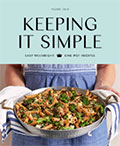 Keeping It Simple
Keeping It Simple
By Yasmin Fahr
Published by Hardie Grant Books
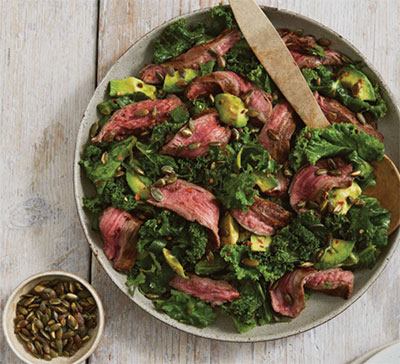 Cumin-Spiced Steak Salad
Cumin-Spiced Steak Salad
This is one of those salads that I make over and over again, sometimes changing it up to add in a bit of feta or different proteins on top, which I highly encourage you to do as well... Cumin happens to be one of my favorite spices; I put it on almost everything I make, from sprinkling some into my scrambled eggs to dousing roasted vegetables with it. If you don't share my love of it, then reduce the amount.
Two 6-ounce skirt or flank steaks, cut across the width of the steak into 5-inch pieces
Salt and freshly ground black pepper
1 tablespoon ground cumin
10 ounces kale or other leafy green, leaves removed from the stems, cut into 2-inch ribbons (about 3 cups)
1/4 teaspoon dried red chili flakes or more as desired
Juice of 1 lemon
2 ripe Hass avocados, halved, destoned, peeled and cubed
1 tablespoon ghee (a form of clarified butter) or 2 tablespoons canola oil
1 ounce toasted pumpkin seeds
1/2 cup coriander (cilantro) or parsley leaves and fine stems, roughly chopped or torn
1. Generously season the steak with salt, pepper and half the cumin, making sure to get it in all the cracks and crevices. Set aside at room temperature while you make the salad.
2. In a serving bowl, mix the kale, remaining cumin, chili flakes, lemon juice and half the avocado; season with salt and pepper. Use your hands to massage the avocado and spices into the kale, making sure it's well coated.
You can be rough and tough with this one, as there's nothing delicate going on here. And it's a good way to take out any residual aggression from the day.
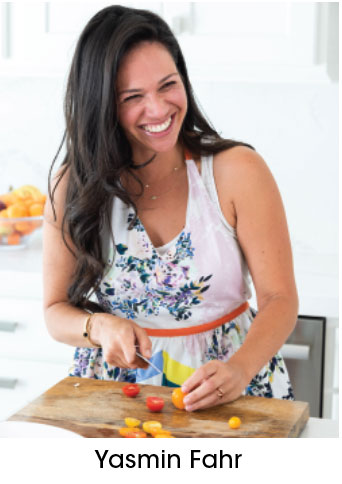 3. Heat the ghee in a 12-inch frying pan over a medium-high heat until melted/lightly smoking. Add the steak in one layer, working in batches if needed, turning over after 3 minutes, and cooking until an instant-read thermometer reaches 125°F for medium rare and 135°F for medium, about 6 minutes total for medium rare.
3. Heat the ghee in a 12-inch frying pan over a medium-high heat until melted/lightly smoking. Add the steak in one layer, working in batches if needed, turning over after 3 minutes, and cooking until an instant-read thermometer reaches 125°F for medium rare and 135°F for medium, about 6 minutes total for medium rare.
(If you feel like the steaks are charring too quickly, then continuously flip them until they finish cooking.) Set aside on a cutting board and let rest for 5–10 minutes while you set the table and pour yourself some wine.
4. Portion the salad onto serving plates, add the remaining avocado cubes, topping them with pumpkin seeds and coriander. Season the steak with a sprinkle of salt, slice against the grain, and distribute on the salad plates, finishing with pepper.
Note: Massaging and cutting the kale helps to tenderize it and rids it of that rough and thick texture. The longer it sits with the avocado, the tastier it is, and it makes for great leftovers.
Serves 2
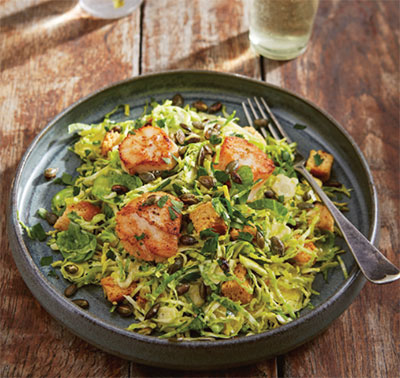 Scallop and Brussels Sprout Salad
Scallop and Brussels Sprout Salad
This vegan Caesar dressing is a slight variation on the one from Haven's Kitchen, a fabulous cooking school, event space and café of sorts in New York City...Why serve a vegan dressing with a protein? In my experience, a lot of home cooks don't want to make a dressing with anchovies and raw eggs (yes, that's in a Caesar, in case you didn't know). Plus, it feels a little lighter, and I'm into that.
1 garlic clove, grated or mashed with the back of a knife until it's paste-like
1 tablespoon miso paste
1 tablespoon Dijon mustard
Juice of 2 lemons
4 tablespoons extra-virgin olive oil
6 cups shredded Brussels sprouts
2 cups croutons
Salt and freshly ground black pepper
2 tablespoons olive oil
12 large scallops, muscles removed
1/2 cup fresh parsley leaves and fine stems, roughly chopped
1/2 cup toasted pumpkin seeds
1. In the bottom of a large serving bowl, combine the garlic, miso paste, mustard and juice of 1 lemon. Slowly pour in the extra-virgin olive oil, whisking at intervals to combine it with the ingredients. Make sure to mash and break up the miso paste and continue until it reaches a smoothish consistency. (It's not going to be perfect as we're doing it by hand, but you could use a hand-held blender if you'd like.)
Add water or more lemon juice to thin out until you achieve your desired consistency and taste. Mix in the Brussels sprouts and croutons until thoroughly combined. Season with salt and pepper and set aside.
2. In a 12-inch skillet over medium-high heat, add the remaining 2 tablespoons olive oil and heat until lightly smoking. Season the scallops with salt and pepper on both sides, then add to the pan, making sure they are not touching each other (work in batches if you need to).
Cook until about halfway up the scallop is opaque and more of a creamy white color than a murky white, about 3 minutes. The scallops should easily release from the skillet pan without resistance (keep cooking if not) and have a nice browned crust on the bottom.
Flip, cooking for 1 more minute for medium-rare, then remove from the stove to allow the residual heat of the pan to finish cooking them. (If you want them fully cooked through, then leave on the heat for 1–2 minutes more.)
3. Squeeze the remaining lemon juice on them, then divide the salad between plates, top with scallops, parsley and pumpkin seeds.
Notes:
If you can purchase shredded Brussels sprouts, do that as a time-saver. Otherwise, use a mandolin or trim them and use a knife to cut into strips.
Variations: Shrimp or chicken work here as well. Swap sprouts for asparagus in the spring or a mix
of kale and romaine.
Serves 4
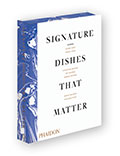 Signature Dishes That Matter
Signature Dishes That Matter
Curated by Susan Jung, Howie Kahn, Christine Muhlke, Pat Nourse, Andrea Petrini, Diego Salazar and Richard Vines
Illustrated by Adriano Rampazzo
Published by Phaidon
Cobb Salad
1/2 head iceberg lettuce
1/2 bunch watercress
1 small bunch chicory
1/2 head romaine
2 medium tomatoes, peeled
2 breasts of roasting chicken
6 strips crisp bacon
1 avocado
3 hard-boiled eggs, shelled and chopped
2 tablespoons chopped chives
1/2 cup crumbled Roquefort cheese
1 cup Brown Derby Old-Fashioned French Dressing (recipe follows)
Cut finely the lettuce, watercress, chicory and romaine and arrange in a salad bowl. Cut the tomatoes in half, remove the seeds, dice finely and arrange over the top of the chopped greens (salad leaves).
Dice the breasts of chicken and arrange over the top. Chop the bacon finely and sprinkle over the salad. Cut the avocado in small pieces and arrange around the edge of the salad. Decorate the salad by sprinkling over with the chopped eggs, chopped chives and crumbled cheese.
Just before serving, mix the salad thoroughly with the French dressing.
Serves 4
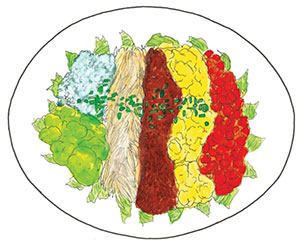 Brown Derby Old-Fashioned French Dressing
Brown Derby Old-Fashioned French Dressing
1 cup water
1 cup red wine vinegar
1 teaspoon sugar
Juice of 1/2 lemon
2-1/2 teaspoons salt
1 teaspoon ground black pepper
1 tablespoon Worcestershire sauce
1 teaspoon English mustard
1 clove garlic, chopped
1 cup olive oil
3 cups vegetable oil
Blend together all the ingredients except the oils. Then add the olive and vegetable oils and mix well again. Chill. Shake before serving.
Note: This dressing keeps well in the refrigerator.
Can be made and stored in a 2-quart Mason jar.
Makes about 1-1/2 quarts